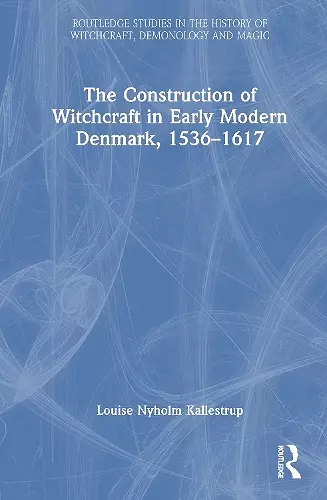The Construction of Witchcraft in Early Modern Denmark, 1536-1617
Louise Nyholm Kallestrup author
Format:Hardback
Publisher:Taylor & Francis Inc
Published:31st Mar '25
£145.00
Supplier delay - available to order, but may take longer than usual.
This hardback is available in another edition too:
- Paperback£39.99(9780815395416)

This book examines how the experience of witchcraft developed and evolved from the Lutheran Reformation of Denmark in 1536 to the celebration of the Lutheran centennial of 1617.
As well as exploring witchcraft, this volume is a portrait of Denmark and how religion and politics in the 16th and 17th centuries were impossible to separate. It was in this period from 1536 to 1617 that witchcraft went from an offence condemned in the Bible and prohibited in the medieval Law of Jutland, to being described in detail as the worst of crimes. Witchcraft evolved from being defined as imposing harm to someone or something, to being a mockery of God. Approaching the theme from the new history of experience, this book refers to the process of the construction of witchcraft as a crime. Contributions draw on a wide range of textual and visual sources, and bring together court records, sermons, legal regulations and correspondence with pamphlets, devotional literature and demonological treaties. The book is the first of its kind that aims to explain how this development occurred.
This volume is useful for undergraduates, postgraduates and scholars, as well as non-specialist readers interested in the history of witchcraft, magic and alchemy, women’s and gender history and European history.
“In her latest study of witchcraft, law, and authority structures, Louise Nyholm Kallestrup, professor of history at Southern Denmark University, carefully and insightfully leads readers through the radically altered landscape of witchcraft attitudes and trials of the post-Reformation Danish empire, culminating in the Witchcraft Act of 1617. It is a world filled with change, where the Pope is seen as the Antichrist, the Second Coming is imminent, and a very real Devil is understood to be a physical, not just a metaphysical, enemy who, in the words of the Bible, 'prowls around like a roaring lion looking for someone to devour' (1 Peter 5:8). And it a world in which the interests and powers of the authorities, ecclesiastical as well as royal, converge, but at the same time, they also rely heavily on the cooperation of the peasant classes. Through the detailed study of selected trials from throughout the empire, from Djursland in eastern Jutland to Norway to both sides of the Øresund, as well as of such political events as the ill-fated wedding voyage of Anna of Denmark and the victorious Kalmar War, Kallestrup skillfully demonstrates the important influence of the apocalyptic propaganda being spread through the medium of the parish churches, the significant role of the emerging image of the ideal Lutheran woman and its antipode, the lustful, disobedient witch, and the belief by the authorities that they were able to cleanse the land of such 'ungodly creatures.'"
Stephen Mitchell, Harvard University, USA
“This is an exciting and very readable book which offers new insights into the history of the early modern Danish witch-trials. Louise Nyholm Kallestrup points to the importance of the Danish Witchcraft Act of 1617, which defined witchcraft as a crime against God, to this history. However, unlike previous scholars, who have mainly looked at what happened after 1617, Kallestrup explores the period from 1536 to 1617 to explain how the Act came into being and what role the ‘godly’ Lutheran King, Christian IV, played in this process. She uses a wide range of sources (including church wall-paintings and morality plays about ‘evil women’ as well as court records and religious texts) and places particular emphasis on the benefits gained from analysing the history of witchcraft using the concepts of experience and epiphany. The book will be essential reading for scholars interested in the history of early modern witchcraft, religion, and gender.”
Alison Rowlands, Professor in European History, University of Essex, UK
“Kallestrup's book is far more than just a new history of the Danish witch trials between 1536 and 1617. Based on her thorough knowledge of the archival sources, visual culture, discourses and practices of the early modern period, she impressively shows how closely ‘thinking with witches’ was linked to the establishment of a Lutheran Godly state. The persecution of witches is thus placed in its wider political, religious and social context. Her book is paradigmatic for further research on witch-hunts, authority and state-building. As a standard work of reference, it deserves a wide readership.”
Prof. Dr. Rita Voltmer, Trier University
ISBN: 9780815395409
Dimensions: unknown
Weight: 560g
200 pages